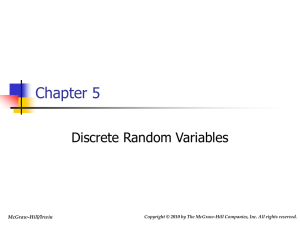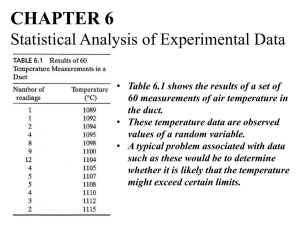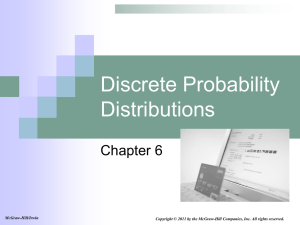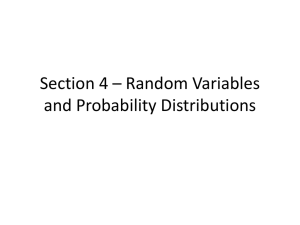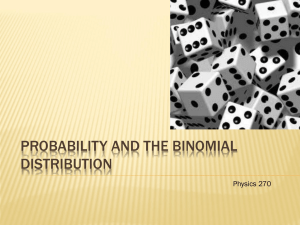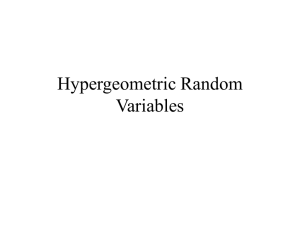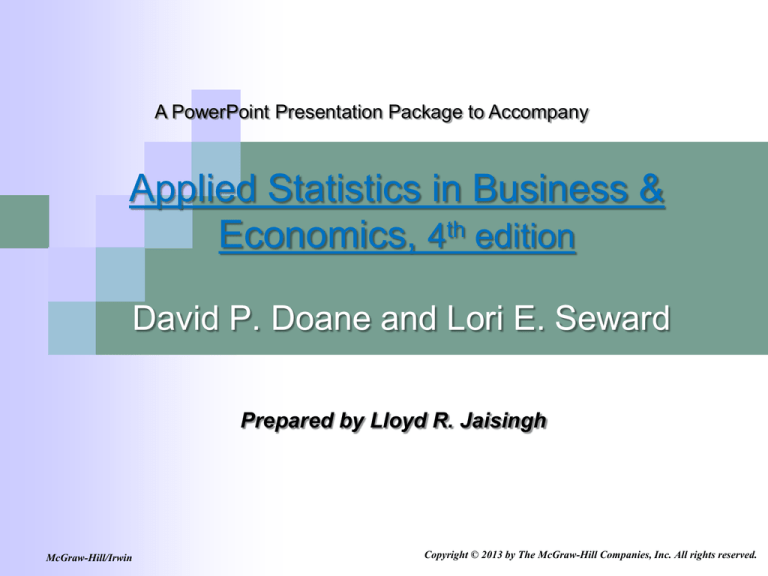
A PowerPoint Presentation Package to Accompany
Applied Statistics in Business &
Economics, 4th edition
David P. Doane and Lori E. Seward
Prepared by Lloyd R. Jaisingh
McGraw-Hill/Irwin
Copyright © 2013 by The McGraw-Hill Companies, Inc. All rights reserved.
Chapter 6
Discrete Probability Distributions
Chapter Contents
6.1
6.2
6.3
6.4
6.5
6.6
6.7
6.8
Discrete Distributions
Uniform Distribution
Bernoulli Distribution
Binomial Distribution
Poisson Distribution
Hypergeometric Distribution
Geometric Distribution (Optional)
Transformations of Random Variables (Optional)
6-2
Chapter 6
Discrete Probability Distributions
Chapter Learning Objectives
LO6-1:
LO6-2:
LO6-3:
LO6-4:
LO6-5:
Define a discrete random variable.
Solve problems using expected value and variance.
Define probability distribution, PDF, and CDF.
Know the mean and variance of a uniform discrete model.
Find binomial probabilities using tables, formulas, or Excel.
6-3
Chapter 6
Discrete Probability Distributions
Chapter Learning Objectives
LO6-6: Find Poisson probabilities using tables, formulas, or Excel.
LO6-7: Use the Poisson approximation to the binomial (optional).
LO6-8: Find hypergeometric probabilities using Excel.
LO6-9: Calculate geometric probabilities (optional).
LO6-10: Select an appropriate discrete model from problem context.
LO6-11: Apply rules for transformations of random variables (optional).
6-4
Chapter 6
LO6-1
6.1 Discrete Distributions
LO6-1: Define a discrete random variable.
Random Variables
•
•
•
A random variable is a function or rule that assigns a numerical
value to each outcome in the sample space of a random
experiment.
Nomenclature:
- Uppercase letters are used to represent
random variables (e.g., X, Y).
- Lowercase letters are used to represent
values of the random variable (e.g., x, y).
A discrete random variable has a countable number of distinct
values.
6-5
Chapter 6
LO6-1
6.1 Discrete Distributions
Probability Distributions
•
A discrete probability distribution assigns a probability to each value
of a discrete random variable X.
•
To be a valid probability distribution, the following must be satisfied.
6-6
Chapter 6
LO6-1
6.1 Discrete Distributions
Example: Coin Flips able 6.1)
When a coin is flipped 3 times, the sample space will be
S = {HHH, HHT, HTH, THH, HTT, THT, TTH, TTT}.
If X is the number
of heads, then X
is a random
variable whose
probability
distribution is as
follows:
Possible Events
x
P(x)
TTT
0
1/8
HTT, THT, TTH
1
3/8
HHT, HTH, THH
2
3/8
HHH
3
1/8
Total
1
6-7
Chapter 6
LO6-1
6.1 Discrete Distributions
Example: Coin Flips
Note that the values of X
need not be equally likely.
However, they must sum to
unity.
Note also that a discrete
probability distribution is
defined only at specific
points on the X-axis.
6-8
Chapter 6
LO6-2
6.1 Discrete Distributions
LO6-2: Solve problems using expected value and variance.
Expected Value
•
The expected value E(X) of a discrete random variable is the sum of
all X-values weighted by their respective probabilities.
•
If there are n distinct values of X, then
•
E(X) is a measure of center.
6-9
Chapter 6
LO6-2
6.1 Discrete Distributions
Example: Service Calls
E(X) = μ = 0(.05) + 1(.10) + 2(.30) + 3(.25) + 4(.20) + 5(.10) = 2.75
6-10
Chapter 6
LO6-2
6.1 Discrete Distributions
Example: Service Calls
This particular probability
distribution is not
symmetric around the
mean m = 2.75.
0.30
Probability
0.25
0.20
0.15
0.10
0.05
0.00
0
1
2
3
4
5
However, the mean is
still the balancing point,
or fulcrum.
Num ber of Service Calls
m = 2.75
E(X) is an average and it does not have to be an observable point.
6-11
Chapter 6
LO
LO6-2
6.1 Discrete Distributions
Variance and Standard Deviation
•
If there are n distinct values of X, then the variance of a discrete
random variable is:
•
The variance is a weighted average of the variability about the
mean and is denoted either as s2 or V(X).
•
The standard deviation is the square root of the variance and is
denoted s.
6-12
Chapter 6
LO6-2
6.1 Discrete Distributions
Example: Bed and Breakfast
6-13
Chapter 6
LO6-2
6.1 Discrete Distributions
Example: Bed and Breakfast
The histogram shows that the distribution is skewed to the left and
bimodal.
0.30
The mode is 7
rooms rented but
the average is only
4.71 room rentals.
Probability
0.25
0.20
0.15
0.10
0.05
0.00
0
1
2
3
4
5
6
7
Num ber of Room s Rented
s = 2.06 indicates considerable variation around m.
6-14
Chapter 6
LO6-3
6.1 Discrete Distributions
LO6-3: Define probability distribution, PDF, and CDF.
What Is a PDF or CDF?
•
A probability distribution function (PDF) is a mathematical function
that shows the probability of each X-value.
•
A cumulative distribution function (CDF) is a mathematical function
that shows the cumulative sum of probabilities, adding from the
smallest to the largest X-value, gradually approaching unity.
6-15
Chapter 6
6.1 Discrete Distributions
LO6-3
What Is a PDF or CDF?
Consider the following illustrative histograms:
PDF = P(X = x)
0.25
CDF = P(X ≤ x)
1.00
0.90
0.80
0.70
Probability
Probability
0.20
0.15
0.10
0.60
0.50
0.40
0.30
0.05
0.20
0.10
0.00
0.00
0
1
2
3
4
5
6
7
8
9
10
11
12
13
14
Value of X
Illustrative PDF
(Probability Density Function)
0
1
2
3
4
5
6
7
8
9
10
11
12
13
14
Value of X
Cumulative CDF
(Cumulative Density Function)
6-16
Chapter 6
LO6-4
6.2 Uniform Distribution
LO6-4: Know the mean and variance of a uniform discrete model.
Characteristics of the Uniform Discrete Distribution
•
The uniform distribution describes a random variable with a finite
number of integer values from a to b (the only two parameters).
•
Each value of the random variable is equally likely to occur.
•
Consider the following characteristics of the uniform discrete
distribution:
6-17
Chapter 6
LO6-4
6.2 Uniform Distribution
Characteristics of the Uniform Discrete Distribution
6-18
Chapter 6
6.2 Uniform Distribution
LO6-4
Example: Rolling a Die
•
0.18
1.00
0.16
0.90
0.14
0.80
0.70
0.12
Probability
Probability
•
The number of dots on the roll of a die forms a uniform random
variable with six equally likely integer values: 1, 2, 3, 4, 5, 6
What is the probability of getting any of these on the roll of a die?
0.10
0.08
0.06
0.60
0.50
0.40
0.30
0.04
0.20
0.02
0.10
0.00
0.00
1
2
3
4
5
6
1
2
3
4
5
Num ber of Dots Show ing on the Die
Num ber of Dots Show ing on the Die
PDF for one die
CDF for one die
6
6-19
Chapter 6
LO6-4
6.2 Uniform Distribution
Example: Rolling a Die
•
The PDF for all x is:
•
Calculate the mean as:
•
Calculate the standard deviation as:
6-20
Chapter 6
6.3 Bernoulli Distribution
Bernoulli Experiments
•
A random experiment with only 2 outcomes is a Bernoulli experiment.
•
One outcome is arbitrarily labeled a “success” (denoted X = 1) and the
other a “failure” (denoted X = 0).
p is the P(success), 1 p is the P(failure).
•
“Success” is defined as the less likely outcome so that p < .5 for
convenience.
•
Note that P(0) + P(1) = (1 – p) + p = 1 and 0 ≤ p ≤ 1.
•
The expected value (mean) and variance of a Bernoulli experiment is
calculated as:
E(X) = p and V(X) = p(1 p)
6-21
Chapter 6
LO6-5
6.4 Binomial Distribution
LO6-5: Find binomial probabilities using tables, formulas, or Excel.
Characteristics of the Binomial Distribution
•
The binomial distribution arises when a Bernoulli experiment is
repeated n times.
•
Each trial is independent so the probability of success p remains
constant on each trial.
•
In a binomial experiment, we are interested in X = number of
successes in n trials. So, X = X1 + X2 + ... + Xn
•
The probability of a particular number of successes P(X) is
determined by parameters n and p.
6-22
Chapter 6
LO6-5
6.4 Binomial Distribution
Characteristics of the Binomial Distribution
6-23
Chapter 6
LO6-5
6.4 Binomial Distribution
Example: Quick Oil Change Shop
•
It is important to Quick Oil Change shops to ensure that a car’s service time
is not considered “late” by the customer.
•
Service times are defined as either late or not late.
•
X is the number of cars that are late out of the total number of cars
serviced.
•
Assumptions:
- Cars are independent of each other.
- Probability of a late car is consistent.
6-24
Chapter 6
LO6-5
6.4 Binomial Distribution
Example: Quick Oil Change Shop
•
What is the probability that exactly 2 of the next n = 12 cars
serviced are late (P(X = 2))?
•
P(car is late) = p = .10
•
P(car is not late) = 1 p = .90
6-25
Chapter 6
LO6-5
6.4 Binomial Distribution
Application: Uninsured Patients
•
On average, 20% of the emergency room patients at Greenwood
General Hospital lack health insurance.
•
In a random sample of four patients, what is the probability that at
least four will be uninsured?
•
X = number of uninsured patients (“success”)
•
P(uninsured) = p = 20% or .20
•
P(insured) = 1 – p = 1 – .20 = .80
•
n = 4 patients
•
The range is X = 0, 1, 2, 3, 4 patients.
6-26
Chapter 6
LO6-5
6.4 Binomial Distribution
Compound Events
•
Individual probabilities can be added to obtain any desired event
probability.
•
For example, the probability that the sample of four patients will
contain at least two uninsured patients is
HINT: What inequality means “at least”?
P(X 2) = P(2) + P(3) + P(4)
= .1536 + .0256 + .0016 = .1808
6-27
Chapter 6
LO6-5
6.4 Binomial Distribution
Compound Events
•
What is the probability that fewer than 2 patients have insurance?
HINT: What inequality means “fewer than”?
P(X < 2) = P(0) + P(1) = .4096 + .4096 = .8192
•
What is the probability that no more than 2 patients have insurance?
HINT: What inequality means “no more than”?
P(X 2) = P(0) + P(1) + P(2)
= .4096 + .4096 + .1536 = .9728
6-28
Chapter 6
LO6-5
6.4 Binomial Distribution
Compound Events
It is helpful to sketch a diagram:
6-29
Chapter 6
LO6-6
6.5 Poisson Distribution
LO6-6: Find Poisson probabilities using tables, formulas, or Excel.
Poisson Events Distributed over Time.
•
•
Called the model of arrivals, most Poisson applications model
arrivals per unit of time.
The events occur randomly and independently over a continuum of
time or space:
Each dot (•) is an occurrence of the event of interest.
6-30
6.5 Poisson Distribution
Poisson Events Distributed over Time.
•
•
•
Let X = the number of events per unit of time.
X is a random variable that depends on when the unit of time is
observed.
For example, we could get X = 3 or X = 1 or X = 5 events,
depending on where the randomly chosen unit of time happens to
fall.
The Poisson model’s only parameter is l (Greek letter “lambda”),
where l represents the mean number of events per unit of time or
space.
6-31
Chapter 6
LO6-6
Chapter 6
LO6-6
6.5 Poisson Distribution
Characteristics of the Poisson Distribution
6-32
Chapter 6
LO6-6
6.5 Poisson Distribution
Example: Credit Union Customers
•
On Thursday morning between 9 a.m. and 10 a.m. customers arrive
and enter the queue at the Oxnard University Credit Union at a
mean rate of 1.7 customers per minute.
•
Find the PDF, mean, and standard deviation:
Note the unit for the mean and standard deviation is customers/minute.
6-33
Chapter 6
LO6-6
6.5 Poisson Distribution
Compound Events
•
Cumulative probabilities can be evaluated by summing individual X
probabilities.
•
What is the probability that two or fewer customers will arrive in a
given minute?
P(X 2) = P(0) + P(1) + P(2)
= .1827 + .3106 + .2640 = .7573
•
What is the probability of at least three customers (the complimentary
event)?
P(X 3) = 1 P(X 2) = 1 .7573 =.2427
6-34
Chapter 6
LO6-7
6.5 Poisson Distribution
LO6-7: Use the Poisson approximation to the binomial (optional).
The Poisson distribution may be used to approximate a binomial by
setting l = np. This approximation is helpful when the binomial
calculation is difficult (e.g., when n is large).
The general rule for a good approximation is that n
should be “large” and p should be “small.”
A common rule of thumb says the approximation is adequate if n 20 and
p .05.
6-35
Chapter 6
LO6-8
6.6 Hypergeometric Distribution
LO6-8: Find hypergeometric probabilities using Excel.
Characteristics of the Hypergeometric Distribution
•
The hypergeometric distribution is similar to the binomial
distribution.
•
However, unlike the binomial, sampling is without replacement from
a finite population of N items.
•
The hypergeometric distribution may be skewed right or left and is
symmetric only if the proportion of successes in the population is
50%.
6-36
Chapter 6
LO6-8
6.6 Hypergeometric Distribution
Characteristics of the Hypergeometric Distribution
6-37
Chapter 6
LO6-8
6.6 Hypergeometric Distribution
Example: Damaged iPods
•
In a shipment of 10 iPods, 2 were damaged and 8 are good.
•
The receiving department at Best Buy tests a sample of three iPods at
random to see if they are defective.
•
Let the random variable X be the number of damaged iPods in the sample.
N = 10 (number of iPods in the shipment)
n = 3 (sample size drawn from the shipment)
s = 2 (number of damaged iPods in the
shipment (“successes” in population))
N – s = 8 (number of nondamaged iPods in
the shipment)
x = number of damaged iPods in the sample
(“successes” in sample)
n – x = number of nondamaged iPods in the sample
6-38
Chapter 6
LO6-8
6.6 Hypergeometric Distribution
Example: Damaged iPods
•
•
This is not a binomial problem because p is not constant.
What is the probability of getting a damaged iPod on the first draw from the
sample?
p1 = 2/10
•
Now, what is the probability of getting a damaged iPod on the second
draw?
p2 = 1/9 (if the first iPod was damaged) or
= 2/9 (if the first iPod was undamaged)
•
What about on the third draw?
p3 = 0/8 or
= 1/8 or
= 2/8
depending on what happened in the first two draws.
6-39
Chapter 6
LO6-8
6.6 Hypergeometric Distribution
Using the Hypergeometric Formula
Since there are only 2 damaged iPods in the population, the only possible values of
x are 0, 1, and 2. Here are the probabilities:
6-40
Chapter 6
LO6-8
6.6 Hypergeometric Distribution
Using Software: Excel
Since the hypergeometric formula and tables are tedious and impractical, use
Excel’s hypergeometric function to find probabilities.
Figure 6.27
6-41
Chapter 6
6.6 Hypergeometric Distribution
LO6-8
Binomial Approximation to the Hypergeometric
•
Both the binomial and hypergeometric involve samples of size n
and treat X as the number of successes.
•
The binomial samples with replacement while the hypergeometric
samples without replacement.
6-42
Chapter 6
LO6-9
6.7 Geometric Distribution
LO6-9: Calculate geometric probabilities.
Characteristics of the Geometric Distribution
•
The geometric distribution describes the number of Bernoulli trials
until the first success.
•
X is the number of trials until the first success.
•
X ranges from {1, 2, . . .} since we must have at least one trial to
obtain the first success. However, the number of trials is not fixed.
•
p is the constant probability of a success on each trial.
6-43
Chapter 6
LO6-9
6.7 Geometric Distribution
Characteristics of the Geometric Distribution
Example: Telefund Calling
•
At Faber University, 15% of the alumni make a donation or pledge during
the annual telefund.
•
What is the probability that the first donation will occur on the seventh call?
6-44
Chapter 6
LO6-9
6.7 Geometric Distribution
Example: Telefund Calling
•
What is p? p = .15
•
The PDF is: P(x) = p(1 – p)x1
P(7) = .15(1 – .15)71 = .15(.85)6 = .0566
•
What are the mean and standard deviation of this distribution?
6-45
Chapter 6
LO6-11
6.8 Transformation of Random
Variables
LO6-11: Apply rules for transformations of random variables.
Linear Transformations
•
A linear transformation of a random variable X is performed by
adding a constant or multiplying by a constant.
NOTE: LO6-10 (not presented) relates to the selection of the appropriate
discrete distribution. Please refer to the text.
6-46


